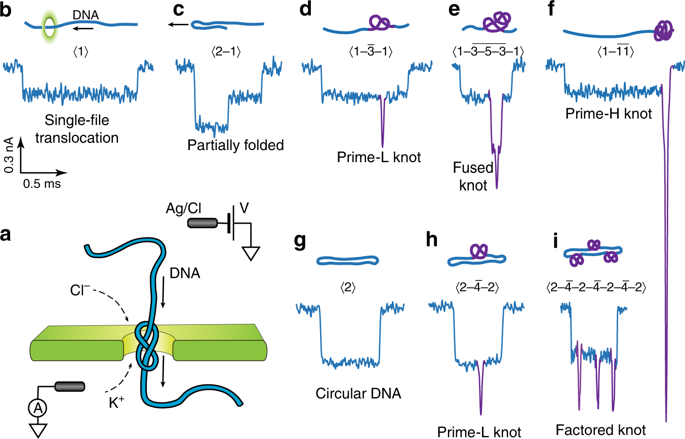当前位置:
X-MOL 学术
›
Nat. Commun.
›
论文详情
Our official English website, www.x-mol.net, welcomes your
feedback! (Note: you will need to create a separate account there.)
Complex DNA knots detected with a nanopore sensor.
Nature Communications ( IF 14.7 ) Pub Date : 2019-10-02 , DOI: 10.1038/s41467-019-12358-4 Rajesh Kumar Sharma 1, 2, 3 , Ishita Agrawal 1 , Liang Dai 4 , Patrick S Doyle 2, 5 , Slaven Garaj 1, 3, 6
Nature Communications ( IF 14.7 ) Pub Date : 2019-10-02 , DOI: 10.1038/s41467-019-12358-4 Rajesh Kumar Sharma 1, 2, 3 , Ishita Agrawal 1 , Liang Dai 4 , Patrick S Doyle 2, 5 , Slaven Garaj 1, 3, 6
Affiliation

|
Equilibrium knots are common in biological polymers-their prevalence, size distribution, structure, and dynamics have been extensively studied, with implications to fundamental biological processes and DNA sequencing technologies. Nanopore microscopy is a high-throughput single-molecule technique capable of detecting the shape of biopolymers, including DNA knots. Here we demonstrate nanopore sensors that map the equilibrium structure of DNA knots, without spurious knot tightening and sliding. We show the occurrence of both tight and loose knots, reconciling previous contradictory results from different experimental techniques. We evidence the occurrence of two quantitatively different modes of knot translocation through the nanopores, involving very different tension forces. With large statistics, we explore the complex knots and, for the first time, reveal the existence of rare composite knots. We use parametrized complexity, in concert with simulations, to test the theoretical assumptions of the models, further asserting the relevance of nanopores in future investigation of knots.
中文翻译:

使用纳米孔传感器检测复杂的 DNA 结。
平衡结在生物聚合物中很常见——它们的普遍性、尺寸分布、结构和动力学已被广泛研究,对基本生物过程和 DNA 测序技术具有影响。纳米孔显微镜是一种高通量单分子技术,能够检测生物聚合物的形状,包括 DNA 结。在这里,我们展示了纳米孔传感器,可以绘制 DNA 结的平衡结构,而不会产生虚假的结拉紧和滑动。我们展示了紧结和松结的发生,调和了之前来自不同实验技术的矛盾结果。我们证明了通过纳米孔发生两种数量上不同的结易位模式,涉及非常不同的张力。通过大量统计数据,我们探索了复杂的结,并首次揭示了罕见复合结的存在。我们使用参数化的复杂性与模拟相结合来测试模型的理论假设,进一步断言纳米孔在未来结研究中的相关性。
更新日期:2019-10-02
中文翻译:

使用纳米孔传感器检测复杂的 DNA 结。
平衡结在生物聚合物中很常见——它们的普遍性、尺寸分布、结构和动力学已被广泛研究,对基本生物过程和 DNA 测序技术具有影响。纳米孔显微镜是一种高通量单分子技术,能够检测生物聚合物的形状,包括 DNA 结。在这里,我们展示了纳米孔传感器,可以绘制 DNA 结的平衡结构,而不会产生虚假的结拉紧和滑动。我们展示了紧结和松结的发生,调和了之前来自不同实验技术的矛盾结果。我们证明了通过纳米孔发生两种数量上不同的结易位模式,涉及非常不同的张力。通过大量统计数据,我们探索了复杂的结,并首次揭示了罕见复合结的存在。我们使用参数化的复杂性与模拟相结合来测试模型的理论假设,进一步断言纳米孔在未来结研究中的相关性。


















































 京公网安备 11010802027423号
京公网安备 11010802027423号